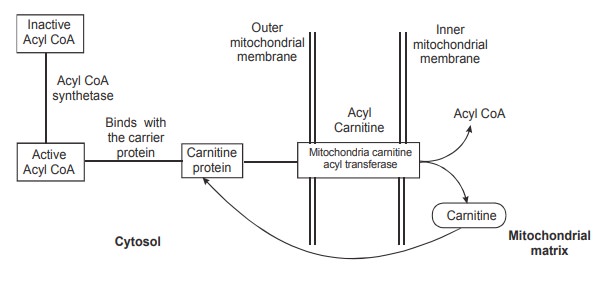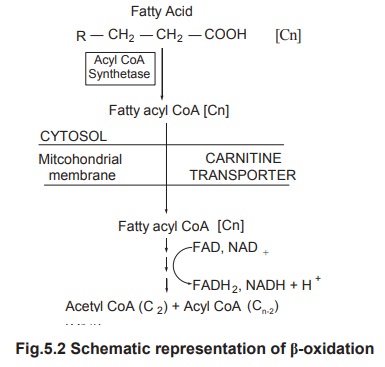Chapter: Biochemistry: Lipid Metabolism
Oxidation of Fatty Acids
Oxidation of Fatty Acids
The digestion of fats starts in the small
intestine. Fats are emulsified by the bile salts and hydrolysed by the
pancreatic lipases to form free fatty acids. These free fatty acids combine
with glycerol (produced by the glycolytic process) to form triglycerides. They
combine with proteins to form lipoproteins and enter into circulation to
perform various biolological functions such as oxidation, storage and formation
of new lipids. Thus the various fatty acids may exist in the free form as well
as in the esterified form (Triglyceride) in blood.
Fatty acids are the immediate source for
oxidation of fats in various tissues viz. liver, adipose tissue, muscles,
heart, kidney, brain, lungs and testes.
1. β-Oxidation
Fatty acids are oxidised to CO2 and
water with the liberation of large amount of energy. Oxidation is brought about
in the mitochondria because all the enzymes required for oxidation are present
in the mitochondria. Oxidation of fatty acids is of three types, based on the
position of the carbon atom which gets oxidised (α, β and γ)

However b-oxidation of fatty acids is
predominant and widely prevalent and it provides large amount of energy than a
and g oxidation. b-oxidation of fatty acids can be conveniently studied under
different stages as detailed below.
Activation of fatty acids
Fatty acids are relatively inert chemical
molecules and hence they must be converted to an active intermediate for the
initiation of b-oxidation. The activation of fatty acids takes place in the
cytosol in the presence of ATP, coenzyme A and acyl CoA synthetase. The
activated fatty acid then enters into mitochondria with the help of a carrier
protein, carnitine in the presence of a enzyme carnitine acyl transferase.

Oxidation of acyl CoA (fatty acid) takes place
through several steps leading to the formation of acetyl CoA (C2)
and an acyl CoA having two carbon atoms less than

the original fatty acid with which the
b-oxidation cycle originally started. Acyl CoA then enters into a similar
oxidation cycle until all the carbon atoms are released as acetyl CoA. These
reactions require cofactors like Flavin Adenine Dinucleotide (FAD) and
Nicotinamide Adenine Dinucleotide (NAD+).
Related Topics